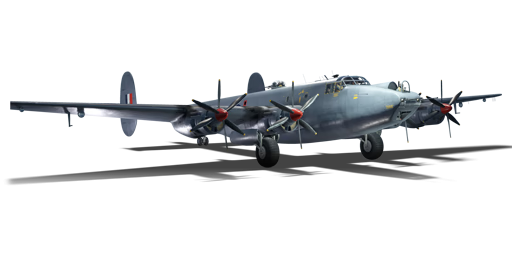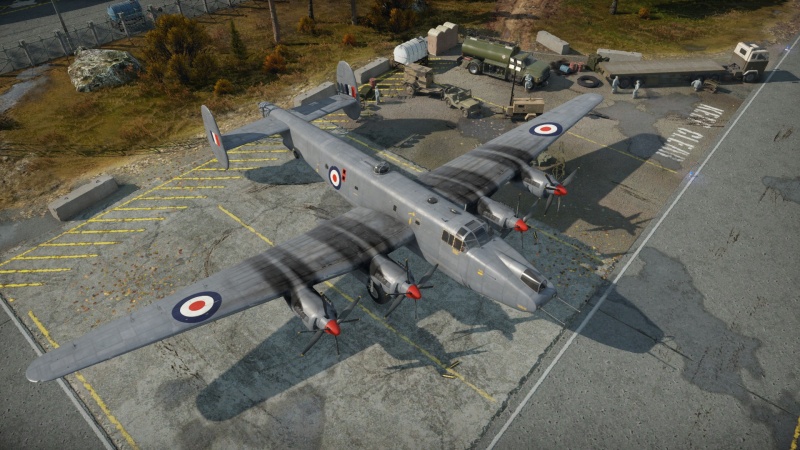Difference between revisions of "Shackleton MR.Mk.2"
Ganymedes73 (talk | contribs) (→History) (Tag: Visual edit) |
|||
| Line 142: | Line 142: | ||
* The bomber risks ripping wings when turning at high speeds (~500 km/h) | * The bomber risks ripping wings when turning at high speeds (~500 km/h) | ||
* No armour, prone to pilot sniping | * No armour, prone to pilot sniping | ||
| − | * Lacks defensive belly | + | * Lacks defensive armament for the belly and tail |
| − | |||
| − | |||
| − | |||
| − | |||
== History == | == History == | ||
<!-- ''Describe the history of the creation and combat usage of the aircraft in more detail than in the introduction. If the historical reference turns out to be too long, take it to a separate article, taking a link to the article about the vehicle and adding a block "/History" (example: <nowiki>https://wiki.warthunder.com/(Vehicle-name)/History</nowiki>) and add a link to it here using the <code>main</code> template. Be sure to reference text and sources by using <code><nowiki><ref></ref></nowiki></code>, as well as adding them at the end of the article with <code><nowiki><references /></nowiki></code>. This section may also include the vehicle's dev blog entry (if applicable) and the in-game encyclopedia description (under <code><nowiki>=== In-game description ===</nowiki></code>, also if applicable).'' --> | <!-- ''Describe the history of the creation and combat usage of the aircraft in more detail than in the introduction. If the historical reference turns out to be too long, take it to a separate article, taking a link to the article about the vehicle and adding a block "/History" (example: <nowiki>https://wiki.warthunder.com/(Vehicle-name)/History</nowiki>) and add a link to it here using the <code>main</code> template. Be sure to reference text and sources by using <code><nowiki><ref></ref></nowiki></code>, as well as adding them at the end of the article with <code><nowiki><references /></nowiki></code>. This section may also include the vehicle's dev blog entry (if applicable) and the in-game encyclopedia description (under <code><nowiki>=== In-game description ===</nowiki></code>, also if applicable).'' --> | ||
| − | |||
| − | + | === [[wt:en/news/7309-development-avro-shackleton-mr-mk-2-the-flight-of-a-thousand-rivets-en|Devblog]] === | |
| + | |||
| + | Following the end of WW2 and going into the Cold War era, submarine development had picked up so much momentum that the previously used submarine counters quickly became obsolete. In addition to this, Britain was faced with a lack of capable long-range maritime patrol aircraft after it was forced to return the lend-lease B-24 Liberator bombers it received during wartime. A stopgap solution in the form of a modified version of the Lancaster bomber was created, but the need for a dedicated maritime patrol aircraft became more and more emphasized in the postwar period. | ||
| + | |||
| + | Development of the Avro Shackleton began in 1945 after the British Air Staff expressed an interest in the conversion of the Avro Lincoln bomber into a general reconnaissance as well as rescue aircraft. As a result, the Avro Type 696 was designed. The Type 696 was primarily based on the Avro Lincoln bomber, but also borrowed some design solutions from the Avro Tudor airliner, of which the latter two themselves were derivative designs of the famous Avro Lancaster. The first prototype, designated Shackleton GR.1, successfully performed its maiden flight in March 1949 and was shortly afterwards ordered into production. | ||
| + | |||
| + | The Avro Shackleton entered service with the RAF in February 1951. The aircraft performed several roles, ranging from its primary role - maritime reconnaissance - over escort and transport duties to search and rescue, whilst being employed all across the globe. However, the aircraft saw numerous modifications during its lifetime, aimed at increasing its capabilities and addressing reliability and structural problems, although at the expense of added weight. The Shackleton and its variants continued to serve throughout the Cold War era, and in the late '80s the Avro Shackleton was finally considered obsolete. | ||
== Media == | == Media == | ||
Revision as of 09:08, 7 June 2022
Contents
Description
The Shackleton MR.Mk.2 is a rank IV British bomber with a battle rating of 5.3 (AB), 6.0 (RB), and 6.3 (SB). It was introduced in Update "Direct Hit".
General info
Flight performance
| Characteristics | Max Speed (km/h at 3,000 m) |
Max altitude (metres) |
Turn time (seconds) |
Rate of climb (metres/second) |
Take-off run (metres) | |||
|---|---|---|---|---|---|---|---|---|
| AB | RB | AB | RB | AB | RB | |||
| Stock | 487 | 469 | 10210 | 31.3 | 32.4 | 7.0 | 7.0 | 1,000 |
| Upgraded | 551 | 515 | 28.9 | 30.0 | 15.7 | 10.5 | ||
Details
| Features | ||||
|---|---|---|---|---|
| Combat flaps | Take-off flaps | Landing flaps | Air brakes | Arrestor gear |
| ✓ | ✓ | ✓ | X | X |
| Limits | ||||||
|---|---|---|---|---|---|---|
| Wings (km/h) | Gear (km/h) | Flaps (km/h) | Max Static G | |||
| Combat | Take-off | Landing | + | - | ||
| 583 | 438 | 425 | 404 | 301 | ~3 | ~1 |
| Optimal velocities (km/h) | |||
|---|---|---|---|
| Ailerons | Rudder | Elevators | Radiator |
| < 350 | < 350 | < 350 | > ___ |
Survivability and armour
The Shackleton MR.Mk.2 has large wings where the fuel tank are located. There are two pilots and eight gunners in total, but only two use turrets, the top gunner and the nose gunner, if the top gunner is taken out the Shackleton becomes much easier to kill. There is only one steel armour plate of 8 mm covering the roof turret gunner.
Modifications and economy
Armaments
Suspended armament
The Shackleton MR.Mk.2 can be outfitted with the following ordnance:
- 18 x 250 lb G.P. Mk.IV bombs (4,500 lb total)
- 25 x 500 lb H.E. M.C. Mk.II bombs (12,500 lb total)
- 15 x 1,000 lb M.C. Mk.I bombs (15,000 lb total)
- 8 x RP-3 rockets
- 8 x RP-3 rockets + 18 x 250 lb G.P. Mk.IV bombs (4,500 lb total)
- 8 x RP-3 rockets + 25 x 500 lb H.E. M.C. Mk.II bombs (12,500 lb total)
- 8 x RP-3 rockets + 15 x 1,000 lb M.C. Mk.I bombs (15,000 lb total)
The 15 x 1,000 lb M.C. Mk.I loadout is ideal to destroy bases and airfields. Only 5 bombs are required to destroy normal bases and 3 to destroy weaker bases. A squad of 3 Shackletons is capable of destroying all bases and the airfield without landing on some maps. Given that most Air RB maps at its BR consist of respawning bases with a prevalence of attackers, you will rarely be able to drop all 15 bombs on bases without having to wait for at least 1 to respawn
Defensive armament
The Shackleton MR.Mk.2 is defended by:
- 2 x 20 mm Hispano Mk.V cannons, nose turret (300 rpg = 600 total)
- 2 x 20 mm Hispano Mk.V cannons, dorsal turret (350 rpg = 700 total)
The 20 mm cannons are mounted at the front and on top of the plane leaving directly behind and below very vulnerable.
Usage in battles
Describe the tactics of playing in the aircraft, the features of using aircraft in a team and advice on tactics. Refrain from creating a "guide" - do not impose a single point of view, but instead, give the reader food for thought. Examine the most dangerous enemies and give recommendations on fighting them. If necessary, note the specifics of the game in different modes (AB, RB, SB).
Manual Engine Control
| MEC elements | ||||||
|---|---|---|---|---|---|---|
| Mixer | Pitch | Radiator | Supercharger | Turbocharger | ||
| Oil | Water | Type | ||||
| Controllable | Controllable Auto control available |
Controllable Auto control available |
Controllable Auto control available |
Separate | Controllable 2 gears |
Not controllable |
Pros and cons
Pros:
- Decent climb rate for a heavy bomber
- Notably powerful WEP
- Self-sealing fuel tanks and overall structural integrity make it resilient to fires
- Heavy bomb load and access to RP-3 rockets
- 20 mm defensive cannons are strong and will destroy most pursuing aircraft
Cons:
- The bomber risks ripping wings when turning at high speeds (~500 km/h)
- No armour, prone to pilot sniping
- Lacks defensive armament for the belly and tail
History
Devblog
Following the end of WW2 and going into the Cold War era, submarine development had picked up so much momentum that the previously used submarine counters quickly became obsolete. In addition to this, Britain was faced with a lack of capable long-range maritime patrol aircraft after it was forced to return the lend-lease B-24 Liberator bombers it received during wartime. A stopgap solution in the form of a modified version of the Lancaster bomber was created, but the need for a dedicated maritime patrol aircraft became more and more emphasized in the postwar period.
Development of the Avro Shackleton began in 1945 after the British Air Staff expressed an interest in the conversion of the Avro Lincoln bomber into a general reconnaissance as well as rescue aircraft. As a result, the Avro Type 696 was designed. The Type 696 was primarily based on the Avro Lincoln bomber, but also borrowed some design solutions from the Avro Tudor airliner, of which the latter two themselves were derivative designs of the famous Avro Lancaster. The first prototype, designated Shackleton GR.1, successfully performed its maiden flight in March 1949 and was shortly afterwards ordered into production.
The Avro Shackleton entered service with the RAF in February 1951. The aircraft performed several roles, ranging from its primary role - maritime reconnaissance - over escort and transport duties to search and rescue, whilst being employed all across the globe. However, the aircraft saw numerous modifications during its lifetime, aimed at increasing its capabilities and addressing reliability and structural problems, although at the expense of added weight. The Shackleton and its variants continued to serve throughout the Cold War era, and in the late '80s the Avro Shackleton was finally considered obsolete.
Media
Excellent additions to the article would be video guides, screenshots from the game, and photos.
See also
Links to the articles on the War Thunder Wiki that you think will be useful for the reader, for example:
- reference to the series of the aircraft;
- links to approximate analogues of other nations and research trees.
External links
| Avro Aircraft | |
|---|---|
| Bombers | Lancaster B Mk I · Lancaster B Mk III · Lincoln B Mk II · Shackleton MR.Mk.2 |
| Export/Licensed | Lancaster MR.7 |
| Britain bombers | |
|---|---|
| Torpedo | Swordfish Mk I · Swordfish Mk II · ▄Avenger Mk II |
| Dive | V-156-B1 |
| Hydroplanes | ▄Catalina Mk IIIa · Sunderland Mk IIIa · Sunderland Mk V |
| Light | Blenheim Mk IV · Beaufort Mk VIII · ▄Hudson Mk V · Brigand B 1 |
| Based on A20 | ▄Havoc Mk I · ▄Boston Mk I · ▄DB-7 |
| Hampden | Hampden Mk I · Hampden TB Mk I |
| Wellington | Wellington Mk Ic · Wellington Mk Ic/L · Wellington Mk III · Wellington Mk X |
| Halifax | Halifax B Mk IIIa |
| Stirling | Stirling B Mk I · Stirling B Mk III |
| Lancaster | Lancaster B Mk I · Lancaster B Mk III |
| Lincoln | Lincoln B Mk II |
| Shackleton | Shackleton MR.Mk.2 |





